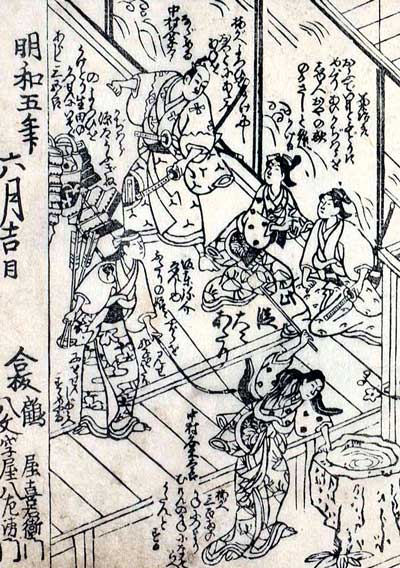| KANZAKI AGEYA |
| Play title | Hirakana Seisuiki |
| Authors | Matsuda Bunk˘d˘ Miyoshi Sh˘raku Takeda Izumo I Takeda Koizumo I Asada Kakei |
| History |
The play "Hirakana Seisuiki" was originally written for the puppet theater (Bunraku) and staged for the first time in the 4th lunar month of 1739 in ďsaka at the Takemotoza. It was adapted for Kabuki the following month and staged for the first time in the 5th lunar month of 1739 in Ky˘to at the Minamigawa no Shibai, produced by Mizuki Tatsunosuke II for the nadai Hoteiya Umenoj˘ [casting]. Then, the play "Hirakana Seisuiki" was performed for the first time in ďsaka in the 9th lunar month of 1740: it was produced at the Kado no Shibai by Nakamura Jűz˘ I and the only know actor in the casting was Nakamura Tomijűr˘ I in the role of Chidori. This play was staged for the first time in Edo in the 7th lunar month of 1753, at the Ichimuraza [casting]. |
| Structure |
The play "Hirakana Seisuiki" is made up of 5 acts. "Kanzaki Ageya", which is also called "Mugen no Kane", is the core of the fourth act. |
| Key words |
Ageya Genpei Kassen Genpei-kassenmono Gidayű Ky˘gen Ichi-no-Tani Ichi-no-Tani no Tatakai Jidaimono Kajiwara Kagesue Kuruwa Miuke Mugen no Kane |
| Summary |
Kajiwara Genta's mother Enju, posing as a samurai, calls on the teahouse where Chidori serves under the name of Umegae, offering to redeem her contract. Meanwhile, Ofude arrives and informs her sister of the death of their father, making her promise to help avenge his murder. Genta comes for his armor, but Umegae tells him that she has pawned it for 300 ry˘. At this news, Genta contemplates suicide, but Umegae promises that she will try to find some way to get it back. After Genta leaves, Umegae remembers the legend of the temple bell called mugen no kane, which is said to provide riches when struck. She takes the water ladle and strikes the water basin, hoping that this will have the same effect. To her astonishment, gold coins rain down from above. They total precisely 300 ry˘, and she rushes off to retrieve the armor. In fact, the coins came from Genta's mother Enju, who has secretly forgiven her son and come to aid him and his sweetheart. Genta is overjoyed to find that Umegae has redeemed his armor. Meanwhile, Umegae's sister Ofude reveals that it was Genta's father Kagetoki who was responsible for their own father's death. She demands that Umegae separate from Genta and help her get revenge, and suggests that they kill Genta for his father's misdeed. Just at this moment, the sisters are struck, but not injured, by headless arrows. Enju comes out and reveals that it was she who gave Umegae the 300 ry˘. She thanks Umegae for aiding Genta, but says that, as Kagetoki's wife, it was her duty to stop the two women from assassinating her husband. Enju commits suicide, dying in place of her husband, and freeing Genta to go to battle and clear his name. Genta dons his armor for the battle in which he expects to die. He puts a sprig of plum blossom in his quiver to symbolize the sweetheart whom he will meet no more (the name Umegae means "plum branch") and sets out for the Battle of Ichi-no-Tani. Source: Valerie L. Durham |
 |
|
The actors Arashi Sangor˘ II (top/left), Band˘ Yasuke (middle/left) and Nakamura Kumetar˘ I (bottom/right) playing the roles of Kajiwara Genta Kagesue, Enju and Umegae in the "Kanzaki Ageya" scene of the drama "Hirakana Seisuiki", which was staged in Ky˘to in the 6th lunar month of 1768 The "Kanzaki Ageya" scene in the 8th lunar month of 1851 at the Naka no Shibai (ďsaka) |
|
|
| Contact | Main | Top | Updates | Actors | Plays | Playwrights | Programs | Links | FAQ | Glossary | Chronology | Illustrations | Prints | Characters | Derivatives | Theaters | Coming soon | News |